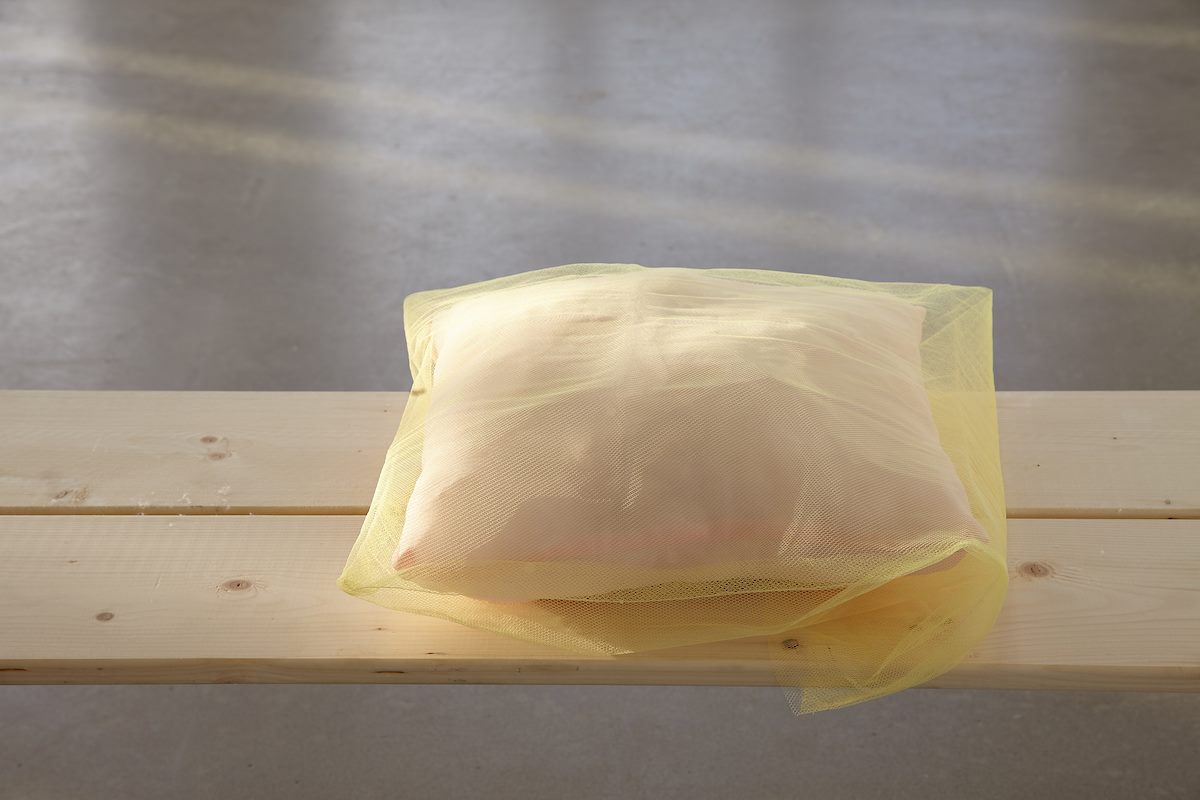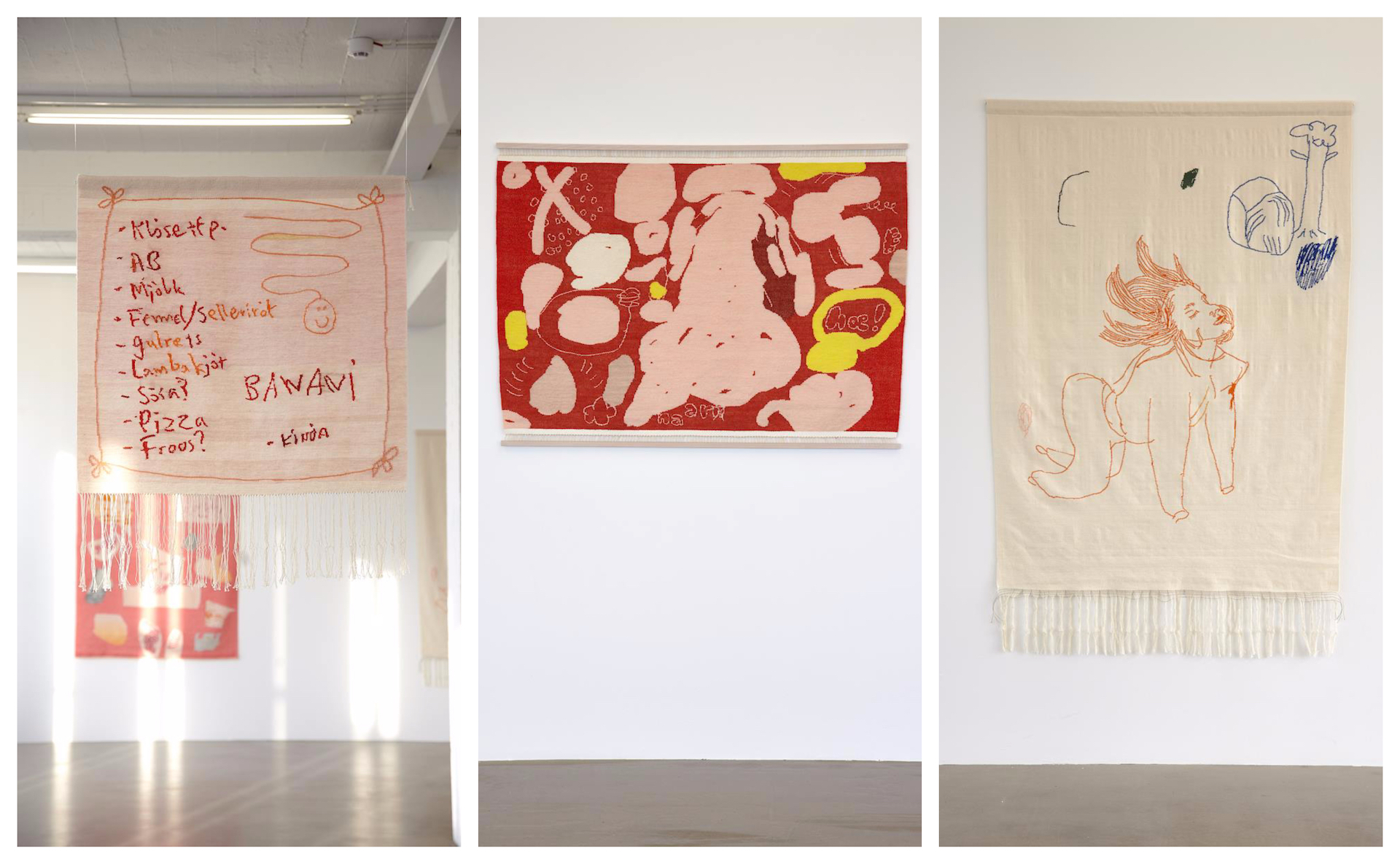
Not with a shout, but with a small cough.
Step into Arna Óttarsdóttir’s solo show Allt Fínt (Everything is Great) and be enveloped by an overwhelming warmth of pinks and oranges and plush texture. The exhibition features mixed media works, which range from woven tapestries to patchwork wall hangings to sculptures of different materials, giving the impression of fragments of a home excised and rearranged in a gallery.
Innkaupalisti (Shopping List) is just that, a shopping list presumably written first on a scrap of paper and then blown up and turned into a weaving that hangs from the ceiling. It’s simple enough, a list of items down the left side, including milk, celery root, lamb, pizza, and an absent minded doodle at the top, as if scribbled while on a long phone call and needing an outlet for restless hands. That’s it, just a hasty scrap of paper reproduced laboriously into an object that declares itself with a tasselled flourish. The genuineness allows me to sink into the reality of it, imagining what was for dinner that night. Are the carrots and celery root to go with the lamb? Is this for a dinner party, or a simple family meal? Certainly not just a meal for one. I begin to imagine the morning routine, perhaps breakfast is AB mjólk and muesli every day, and the house has run out of AB mjólk. Or is there a baby in the house and that’s what it eats? Is the doodle actually an automatic drawing made by an adult, or a child’s intentional step towards self expression? The writing of Lydia Davis comes to mind, micro stories using brevity to such a degree that Davis creates entire narratives in stories that are only one or two sentences. This throw away object transformed into a tapestry has not changed in its meaning, but the transformation does reframe its value from utility into an entryway to meditation on routine, consumerism, self care, or any place the viewer cares to go when imagining all the context surrounding the artefact of this one shopping list.

Sápur (Soaps) is likewise engaging, 18 apparently handmade soaps arranged in an approximate grid on a table (itself composed of numerous folded white cloths like so much fresh laundry). Each soap is presented on a different plinth, a shoulder pad, a piece of hrökkbrauð, an overturned tupperware box, the plastic net that comes around a bottle of duty free wine, and more. Each soap is different, some translucent, some opaque, each embedded with various materials and items, from neon plastic netting to bundles of strings, to glitter and dried flowers, and most intriguingly, dried noodles.
Though there is a definite air of cleanliness and tidying present in the overall arrangement, these soaps are not for cleaning or sudsing. They become less functional items created and used for a task (cleaning) and more something else. What are they? Gems? Insects trapped in amber? Time capsules? A small and orderly sculpture garden? What is the relationship between soap and plinth? And why are these specific items all here together? They’re compiled of things you’d find while cleaning underneath the couch, or in a junk drawer, yet here they all are, arranged in their own specific places.

As I walk from piece to piece, I begin to have the thought “What is the point of this?”. I’ve been enjoying the intro and outrospection from some of the works, and certainly feel physically good in a room full of pink and orange and natural light. But why is this here? Visitors come in, look around for three minutes before leaving, and I imagine them thinking one of two things, either, “This stuff is nice, but who has time for this? The world is burning and I am supposed to lose myself in a landscape of dried flowers? And spend more than five seconds looking at an old grocery list? Everything is great? No, it is not.” or, “Oooh, these soaps are just darling, they’d make a fun Christmas gift.” I think about self indulgence in fine art, questioning what it means to make things that are pretty, to make things that are useless, that drive no change in the world.
But as I watch other people watching, I think that maybe we are all missing the point. The title of the show, Everything is Great, is so tongue in cheek. It’s the response to when someone asks you how things are going, and you don’t want to get into how things aren’t actually going great, but that’s not a socially acceptable response, so you just say, “Everything’s fine.” This work is well aware how the world is garbage, but it’s not so preoccupied with the worry that every effort and work must have a clear purpose of bettering the world in order to be of worth. Another clue comes from a textile collage titled Bleik klippimynd (Hvað get ég svo sem gert?) or Pink Collage (What Can I Do Anyway?). It’s got that question on there, and that becomes the thought pervading the entire show. It’s not despair, but rather permission to lose oneself, if only for a few moments, in a miniature world of soap sculptures, pondering why they are arranged the way they are, or to imagine the life of the person who wrote that shopping list.

Every piece in Allt Fínt has such delicious color and texture that the overall effect is like biting into a cold and refreshing fruit on an unusually warm spring day. Taken all together, the collected works are scraps gathered from around the home and re-presented as textile collages, textures draped over forms, swatches and samples, sketches and notes for later. These pieces are inconsequential things repurposed to demand thought, that expect consequence, not with a shout but with a small cough.
Rebecca Lord
Photo credits: Vigfús Birgisson
Allt Fínt / Everything is Great is on view at Nýlistasafnið until Sunday the 28th of April.
